Even though Amazon’s hardware Kindle reader will be toast at 9AM Saturday morning, Amazon has just released its Kindle app for the iPad.
The app is free and available for download from the App Store.

Even though Amazon’s hardware Kindle reader will be toast at 9AM Saturday morning, Amazon has just released its Kindle app for the iPad.
The app is free and available for download from the App Store.

It’s April 3rd weekend, which means a good number of you will be trying out some of the first iPad games to hit the App Store. I, living in Germany, am not be so lucky: my own iPad won’t be delivered until some still unknown date in the farther-flung days of April. Instead, I’m still stuck gaming on my iPhone, but luckily, I’ve got one of the best and hardest-core games on the App Store to entertain me this weekend: Sword of Fargoal.

https://www.youtube.com/watch?v=sXTbpJt7nn8
Like the Silent Bodyguard app we mentioned two weeks ago, KamAlert will, in an emergency, text authorities — or whomever the user wants — and include details like GPS data in the messege. But KamAlert claims to add two powerful security features: a sensor that uses the camera to detect motion that can automatically trigger a customizable function that sends photos or video to pre-selected recipients, and an audible alarm (in addition to the silent one that both apps possess).
All the features can be adjusted or turned off to avoid, say, the possible embarrassment and/or legal issues resulting from accidentally emailing the cops evidence of your latest frat/sorority party.
For those interested in an inexpensive, portable gadget to augment home security, and if the $5 app works as advertised, it sounds like a valuable, highly customizable security tool; if it doesn’t, well, the iPhone probably makes a decent shuriken.

It’s time for our weekly digest of tiny iPhone reviews (well, it’s a day early, but, you know, it’s a holiday weekend, so…), courtesy of iPhoneTiny.com, with some extra commentary exclusive to Cult of Mac.
This time, we review Chemical Pixel, Color Magic Deluxe, ..™, Easy Beats Pro, Looptastic Gold, Rotate Video, Saturation, Vector Tanks Extreme, Vellum, and Water Your Body.
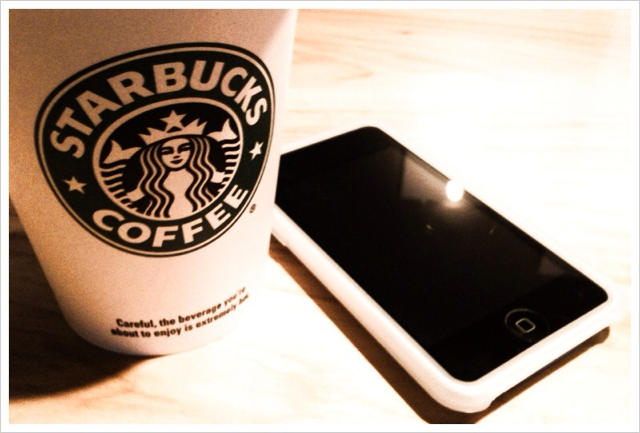
For about six months now, Starbucks has been testing a system in about a dozen Seattle and Silicon Valley stores that turns the iPhone into a virtual wallet, letting customers pay for lattes and the like with an app that displays a barcode read by a specialized reader at the counter.
But yesterday, Starbucks said the trick will expand to 1,000 Starbucks shops inside Target locations. Which is a little odd, considering Target’s demographic (yes, I’m suggesting a large chuck of Target shoppers may not even know what an iPhone is — despite the fact Target hawks Apple stuff — let alone be aware that, yes, there’s an app for that. In fact, the shift manager at my local Starbucks hadn’t even heard of the program).
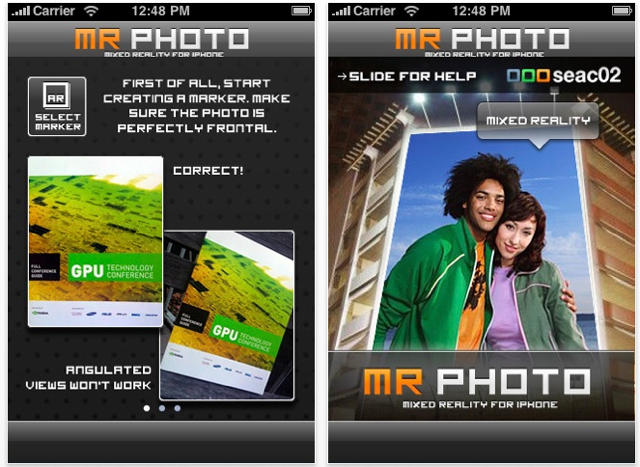
Ever wanted to make it look like it was your face on the massive billboard you pass every day on the way yo work? Sure. We all have — and now we can, sorta, thanks to a new app called Mr. Photo from Italian developer Seac02.
Have a look at the English-disadvantaged blurb from the app’s App Store page, and everything will become clear:
“MrPhoto 1.0 is the first genuine Augmented Reality focus with realtime hardness tracking and user generated hardness target. The focus allows to supplement any design from a fire done by a iphone camera, Augmented being algorithm will take caring of a viewpoint of a Augmented being content. Take a print of an outside promotion print and put your design with a single click, no photoediting during all MRphoto and his record will do anything for you. MRPhoto is a initial genuine step to visible tagging, user generated tags for user generated contents.”

httpvhd://www.youtube.com/watch?v=DKSQryLmqlA&feature=player_embedded
If you’d told me yesterday that I’d be eagerly anticipating a new release by nu metal doofus band Linkin Park, I would have promptly puked up my entire central nervous system… but today, I’m holding my stomach, keeping my mouth closed and my nostrils pinched shut, because Linkin Park’s upcoming iPhone game doesn’t just look good… it looks fantastic.
Perhaps what’s so great about Linkin Park 8-Bit Rebellion is that it somehow manages to cater to both Linkin Park fans (a blight on the species which makes a strong argument for eugenics) and those who find the band’s metal-and-rap-for-fratties musical style nauseating in equal measure. It’s a game with a sense of humor about its subject, not exactly the kind of thing you’d expect from Linkin Park.
The game pits the members of Linkin Park in 16-bit pixel art glory, battling an infection of 8-bit sprites with fun weapons ranging from flamethrowers to super lasers. Even better: Linkin Park’s oeuvre of unlistenable audiophonic vomit is taken and distilled until each song has become a fun, warbling chiptune, which you can choose to listen to instead. Excellent!
Even Linkin Park haters like me should check out the trailer above: this may be the iPhone game I’m looking forward to most right now, god help me.

In the final frontier of the App Store, the upcoming, Star Trek-inspired iPADD app boldly goes where no app has gone before beaming the tablet technology of the 24th Century to the iPad of the day.
Oh, sure, it’s just a neat little skin with some clever sound effects for a rudimentary journal program (the “Captain’s Log”) , e-mail, Twitter and Facebook… but even so, this is going to be a big hit at the Con.

Ever the genius engineer, Woz has figured out a simple and elegant way to run two iPhone apps simultaneously (otherwise known as multitasking).
He has two iPhones.
Having two iPhones also doubles his battery life.
“By the way, I solved the problem of battery life and [the lack of] multitasking on the iPhone,” Woz told Dan Lyons of NewsWeek. “I just have two iPhones, so if the battery runs down on the first one, I can use the other. And if I’m talking on one, I can use the other one to look something up. You would not believe how much use I get out of that.”
Genius.
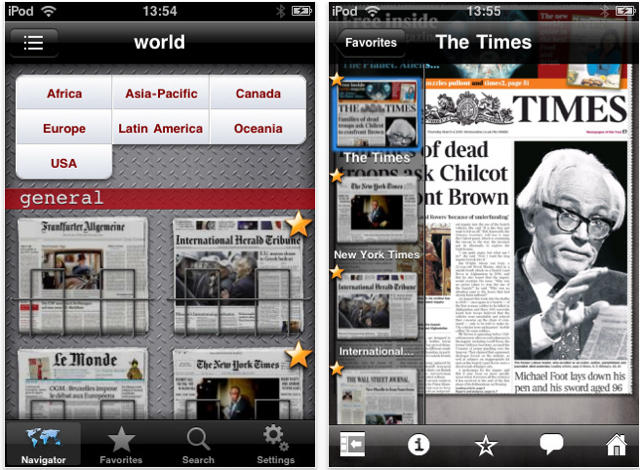
As a journalist, and a bit of a design geek who’s dipped a toe into the arcane world of tabloid page layout, it’s always oddly thrilling for me to read from a front page that’s actually been printed. Or at least looks like it was intended to be printed.
Kiosko.net, a virtual gallery of the day’s front pages from the world’s top newspapers, is one of those must-visit sites if you’re a newspaper aficionado — and now it has an iPhone app (and yes, it really has gotten to the point where we start making references to newspapers as if they were LP records or Sinclair Spectums).


One of the coolest new features introduced in Leopard’s version of Mail is the ability to automatically add contact details to Address Book. Just hover the mouse pointer over something that looks like an address or phone number, and a box magically appears that lets you import the info, with the details brilliantly ending up in the right places. Well, good news: Now, an app has brought the feature to the iPhone.
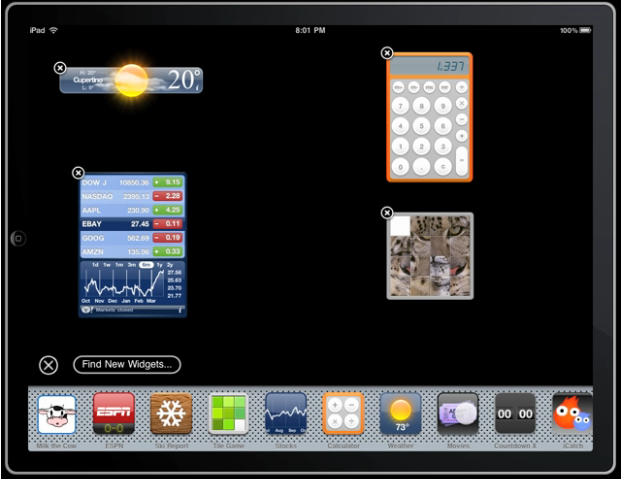
Although a few wishful thinkers held out hope far past Apple’s announcement, it’s pretty clear at this point that the iPad’s not going to have an OS X like dashboard out of the gate… but that’s not to say a third-party developer can’t step in to pick up the slack.
Cernegie Mellon Student Rich Hong has just released this teaser video for his widget-based dashboard app for the iPad. It looks and acts just like OS X’s own Dashboard capabilities, which is great. Just pluck this in your springboard and you”re golden.
There’s no telling if Hong’s Dashboard app will catch-on — third-party widget support will be key here — but it looks fantastic. In fact, with the right widgets, an iPad Dashboard app might allow for some remedial multi-tasking (say, writing a report while simultaneously referencing an article in an adjacent browser widget) until iPhone OS 4.0 creeps out.
[via Techcrunch]

Sure, a picture is worth a thousand words, but why settle for a measly thousand words when you can cram 10,000 into one panoramic mega-photo!? Well take heart shutter bugs, Autostitch Panorama is here to give you the verbose images you so desire.
Autostitch is super simple to use. It works like this. Using your favorite camera app, take a bunch of pictures of whatever you want in your mega-photo. As you snap away, try to have each photo you take overlap about 1/3 of any other photo you take (so AutoStitch knows how the images fit together). When you’re content you’ve captured everything, import all those photos into AutoStitch, hit one button, and boom! baby, Autostitch births a giant panoramic image just for you!
“But surely the images don’t look that good,” you say in half murmur. Not so! Since picture quality was my primary concern, I decided to put this little app through some tests, creating panoramic mega-photos of all sorts of different sceneries.

If you”re curious about how you’ll browse the App Store on your iPad, look no further than this video.
It’s a familiar and intuitive experience. In short, it’s more like browsing the App Store through iTunes on your Mac than launching the App Store on your iPhone, with apps displayed in multiple columns and big, beautiful Coverflow.
The one big thing that stands out to me about the video is that much like the launch of the iPhone App Store, developers are still experimenting with how to price, name and list their apps.
Understandably, iPad apps cost more than their iPhone versions… but expect a lot of fluctuation here, as App Store developers try to figure out if the iPad App Store can escape the $0.99 curse of iPhone apps.
It’s also interesting the naming conventions developers are using to differentiate their iPad versions from the iPhone apps are all over the place. Fieldrunners for iPad is listed right below Flight Control HD, and XL is also a naming convention that is gaining traction. Presumably the different naming schemes will be consolidated at some point… my guess with a little bit of strong-arming on behalf of Apple.
Personally, I prefer HD, which not only plays up the iPad’s higher-resolution display but also keeps extraneous characters down to a bare minimum.
[via Mac Stories]
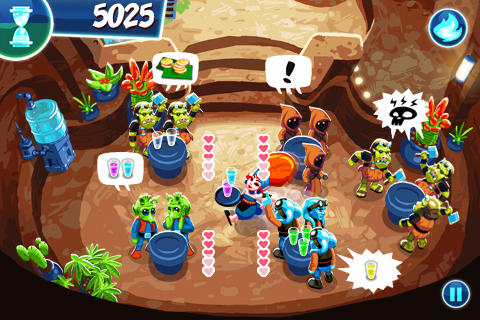
Star Wars titles on the iPhone tend to be bog-standard, lightsaber-swishing affairs, but THQ Wireless looks like they finally might have a Star Wars game in development that’s worth picking up: Star Wars Cantina.
As the title perhaps implies, this is a light-hearted simulation of running a cantina at the famous Mos Eisley Spaceport.
According to the official blurb, “Your task is to see that the right beverage finds its way to the right customer. And don’t keep them waiting, some of the customers are real troublemakers! Working towards your daily quota, accuracy and speed are essential. As a reward for a job well done, outfit your cantina with decorations and attractions to appeal to even the most difficult customers.”
Star Wars Cantina should be coming to the App Store soon. It looks great. Now what about the HD version?

It’s time for our weekly digest of tiny iPhone reviews, courtesy of iPhoneTiny.com, with some extra commentary exclusive to Cult of Mac.
This time, we review Action Bowling Free, Advent Annihilation, Alien Glyphs, Color Expert, Cross Fingers, Fingerzilla, Minigame Party, Monkey Flight, Sound Warp Free, Super KO Boxing 2 Free, and Vintage Video Maker.

Trapster is a popular iPhone app that alerts drivers to police speed traps, red light cameras and DUI checkpoints. It’s attracting between 15,000 and 50,000 new users a day. Among those new users are are some of the most unlikely – the police themselves.
Trapster is partnering with several police departments to get cops to add their own traps to the database. The company is training cops how to use the software. The Travis County Sheriff’s Department in Austin, Texas, is already publicizing its use of the app, and the company expects to announce more partnerships soon.
“It’s more effective at slowing people down than issuing citations,” says Trapster founder and CEO Pete Tenereillo. “It’s not about revenue; it’s about enforcement.”
Travis County Deputy Tom Carpenter told a local TV news crew the same thing: “Our job is compliance, so if I can slow traffic down by just being there, that works too,” he says.
Tenereillo disclosed more interesting facts: Trapster’s biggest competition is not nav apps, but Pandora. And even though navigation apps are popular, people hardly use them.
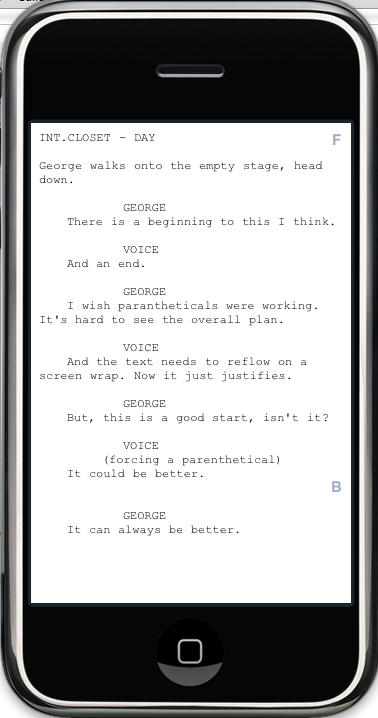
Auteurist is an all-purpose multitool for writers with iPhones, boasting an impressive array of features and different writing modes.
Its developer has been keeping users up to date with progress at the Auteurist Posterous, and in the latest post looks in detail at the challenges of creating a decent scriptwriting mode.
One interesting approach is to make the script on the iPhone screen look right, even though it doesn’t actually follow any rigid formatting rules. It looks as it should, and that’s sufficient on the iPhone screen; yet when you choose to export the finished script to a desktop computer, Auteurist will do the proper formatting on-the-fly, ensuring the final output meets the standards that people who read scripts will expect.
It’s still a work in progress, but it’s interesting to see the progress as it happens. And as the developer notes, things will get much more interesting when a future version of the app is ready for iPad.
Part of me wants to run a mile away from writing apps on the iPhone, simply because I can’t imagine wanting to write anything of any length on it. But another part of me knows the feeling of being struck by sudden inspiration, and having nothing but an iPhone with me to start writing on.
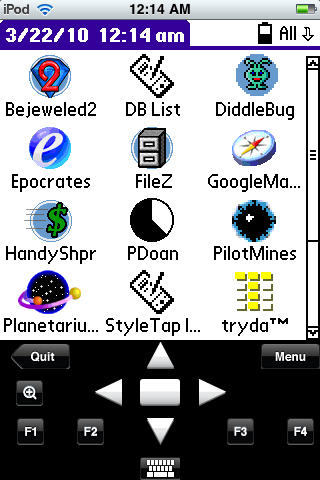
Early last year, Palm bet the farm. They hired a bunch of ex-Apple engineers, killed off all of their old Palm OS devices and announced a new smartphone operating system, webOS, the first truly exciting alternative to the iPhone OS since its unveiling in 2007. They went all in, with their only conciliatory gesture to the existing Palm OS ecosystem a third-party emulator.
Unfortunately, as great as webOS is, that gamble hasn’t paid off for Palm: they are now in dire financial difficulty, and it looks likely that the once revolutionary mobile device maker will soon only be remembered as a footnote in smartphone history.
It’s a shame, and the death of Palm might otherwise have signified the final death of PalmOS, which — before the App Store — was perhaps the most vibrant, crowded and creative platform of mobile app development.
Good news for Palm OS nostalgists, though: the StyleTap emulator has just come out on Cydia, allowing anyone with a jailbroken iPhone or iPod Touch to use it to run Palm OS apps. It’s a bit pricy at $49, but at first blush, StyleTap looks pretty flawless. If the impending death of Palm has you finally considering trading your Pre in for an iPhone, StyleTap will help make that transition a bit easier.
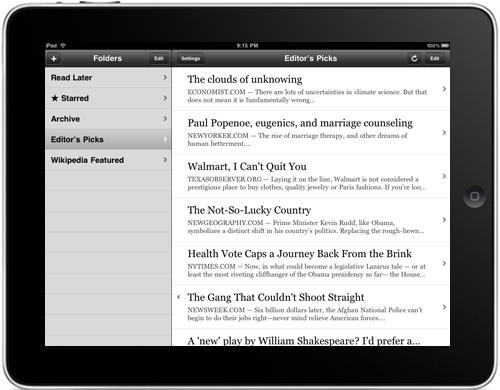
There are a few apps I find absolutely indispensable, and Instapaper Pro is at the top of the heap. When I find an interesting long article during the day (for example, this wonderful New York Times piece on the evolution of the science museum from wunderkammer to proslytizer) I just click Instapaper’s “Read Later” bookmark and give it the attention it deserves later, in a stripped down, paginated, ultra-readable iPhone-friendly format.
I’ve been eagerly anticipating what Instapaper developer Marco Arment had up his sleeve for the iPad version, and now he’s given users a sneak peek on the official blog. There’s no huge surprises here, which even Arment admits: “No multi-column reading, no fake book-page animations, and no giant newspaper graphics,” he says. Never the less, it looks perfect, right down to the dual-pane navigation view. Even better: Arment says that existing Instapaper Pro customers will get the iPad version for free.
Once Apple.de gets around to allowing me to buy an iPad, I think this is the app I’m most looking forward to giving a try. I intend on buying the stock 16GB iPad WiFi, and Instapaper is that rare app that actually gets better and more indispensable when you don’t have a mobile broadband connection. This is a must have program for everyone who loves reading, and reading’s going to be the thing the iPad excels at most.

No one here’s going to argue that the App Store can’t be arbitrary and borderline tyrannical… but you know, sometimes developers get what’s coming to them: Zits & Giggles, a high-brow dermatological simulator, has been pulled from the App Store after its creator, Tommy Refenes, told an audience at San Francisco’s Game Developer Conference that he “absolutely f***ing hate(s) the iPhone App Store.” And that f-bomb ain’t “fudge.”
Of course, there’s more to this than that. Refenes seems to have had an axe to grind with Apple, having raised Zits & Giggles price from $0.99 to $15.99 to $299.99 to $399.99 over a period of about six months. Shockingly, the app still managed to sell fourteen copies at the price of $299.99.
What was the point of all of this? To prove how crummy the App Store is because it’s not aimed at “real gamers,” apparently.
“My conclusion to all of this is that the people you’re selling games to on the App store, they’re not necessarily gamers. There are some games that sell very well on the App store, but for the most part, when you have stuff like Street Fighter and Assassin’s Creed, the are a way to sell a brand, just like the Tiger handhelds were,” said Refenes.
Something tells me that Apple couldn;t really care less about some punk kid mouthing off, and this is really about selling a zit-bursting simulator for more than the cost of a real-life visit to a dermatologist.
Whatever, though: I think this is one zit on Apple’s backside we’re all perfectly happy to see excised.
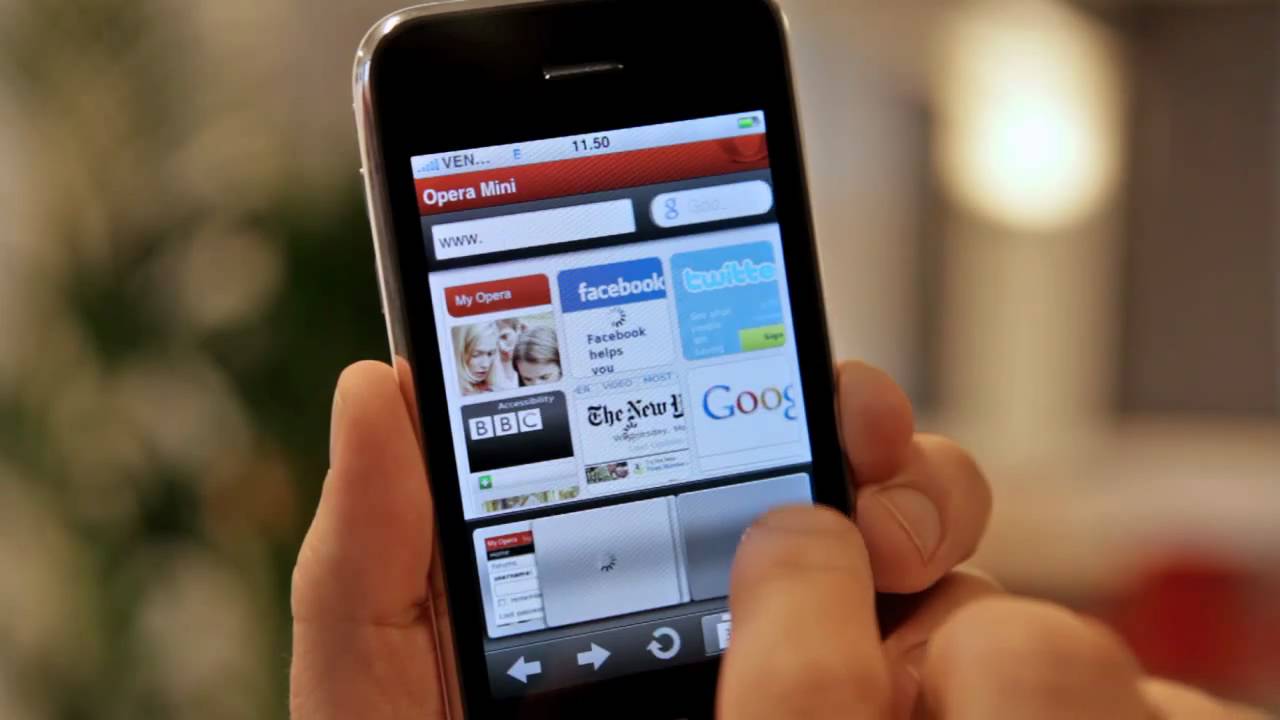
httpvhd://www.youtube.com/watch?v=OpTCS3g-cBY
According to a long and enthusiastic press release (doubtlessly designed to bring as much attention to the approval process as possible), Opera has announced that they have submitted their Opera Mini browser to the App Store.
Although Apple often takes an unfavorable view upon applications which duplicate functionality of built-in iPhone apps, Opera thinks their Mini browser gets around the issue by refusing to execute code natively on the handset. Instead, it asks Opera’s servers to translate, optimize and render the data into a format that only the Opera Mini browser can understand.
The result? A browser that is supposedly up to five times faster than Mobile Safari, especially on EDGE.
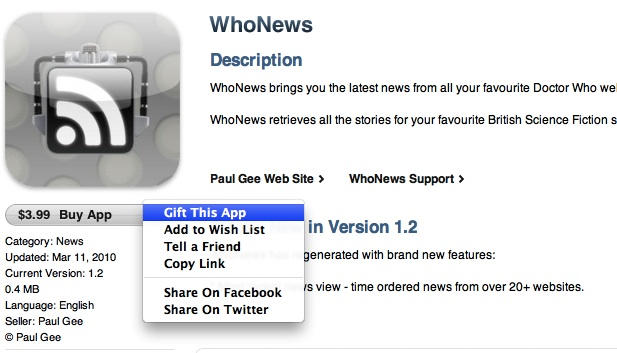
From time to time I come across an iPhone app I think would make a great gift for a friend or family member (in this case, my mom, since she has an iPod Touch and everyone else in my family is either Apple-phobic or a Luddite). Problem is, it just seems too authoritarian to send them a $5 iTunes Store gift card with stipulations on how to spend it.
Well, problem solved: Apple is apparently now allowing individual apps to be given as gifts. Although no official word has come from Apple — the heads-up comes from the folks at TUAW — I clicked on the “Gift This App” menu item and, sure enough, was taken to a screen to handle the details.
Presumably, the gift is actually a code similar to the redeem codes app reviewers typically receive from developers when reviewing apps. The gift can be emailed or printed out and mailed, but can only be redeemed by residents of the same country as the purchaser, and can’t be bought with iTunes store credit.
[via TUAW]

Here in the UK, politics is in a strange limbo and will be for the next few weeks. The sitting Labour government has to call a General Election very soon (most bets are on April 6th for Prime Minister Gordon Brown to visit the Queen to ask her permission).
As a result, not much is happening. The political parties are making frantic behind-the-scenes preparations for the election, while the politicians are going through the motions, waiting for the official election announcement to be made.
All of which makes this morning’s speech by Prime Minister Gordon Brown, in which he announced a new official 10 Downing Street iPhone app, all the more surreal.
Brown is not well known for any love of technology (although I think he’s slightly more tech-savvy than his hopelessly Luddite predecessor Tony Blair, who openly admitted his complete ignorance of all things technical). But what annoys me more than anything else is that Brown should waffle on about Britain’s digital future on one hand, while his Government desperately tries to push the disastrously flawed Digital Economy Bill through Parliament with the bare minimum of debate.
That Bill, if passed, will allow household internet connections to be cut off permanently on the say-so of vaguely-defined “copyright holders”. The music and film industries are strongly in favour; pretty much everyone else, including the ISPs, is very strongly against. It’s a case of lobbying overtaking common sense.
If you live in the UK and, like me, you think this rush to push through a bad law is a bad thing, you should do something about it – soon.
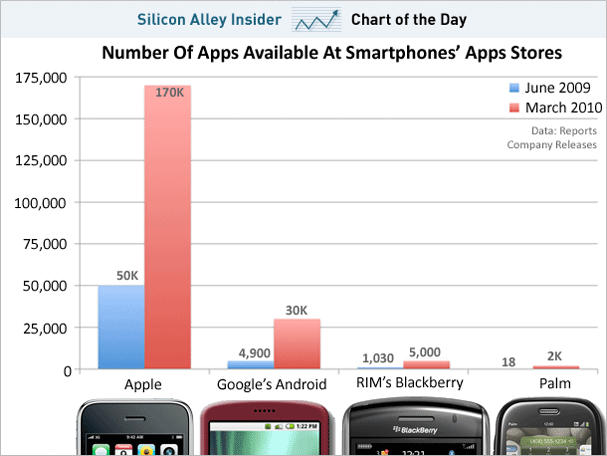
Not that there was any doubt which app marketplace had the most apps out there, but sometimes, seeing it all laid out there as empiric data points on a chart can really put things in fresh perspective.
Take this chart just posted by Silicon Valley Insider, which ranks all four major smartphone providers according to how many apps they have available on their marketplaces.
Of course, we knew Apple was destroying pretty much everyone out there in volume of apps available. Of the competition, Android’s doing best: they’ve multiplied their app catalog sixfold in the last nine months (to Apple’s own 3.5x) but unless they keep that up for the next 18 months, they’re not likely to catch up… especially with the iPad imminent.
As for RIM and Palm? The fresh perspective here isn’t that Apple’s beating the competition… it’s that they’ve managed ripped the heads off of both RIM and Palm’s steaming App Marketplace trunks.